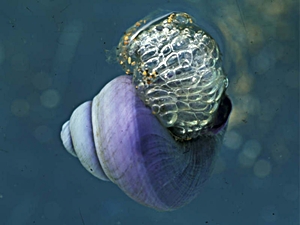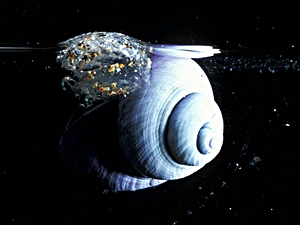The open sea takes up about 80% of the woldwide ocean surface, but only 1% of the overall ocean biomass develops there. Marine vegetation's growth is limited by the lack of nitrogen and phosphorus, this also has consequences for the animal world, herbivores on one hand, predators on the other.
Most marine gastropods develop by veliger larvae, whose sail-like appendages have led to their name “sail-bearer”, and which disperse as plankton. In contrary to that, the adult snails live on the coast (littoral) or on the ocean floor (benthic), to use the rich supply of food and to find protection from enemies. There are, though, some few pelagic snail species really living in the high sea. Mostly those are species like the violet snails, that feed on equally pelagic jellyfish (Coelenterata).
![]() Marine Gastropods: Ecology and Habitats:
Open Sea.
Marine Gastropods: Ecology and Habitats:
Open Sea.
 Violet snail (Janthina janthina). Picture: Steve Trewhella, Marine Life Network. |
Violet snails (Janthinidae) are holopelagic gastropods, remarkable inhabitants of the high sea. Other that sea slugs able to swim freely, violet snails have retained their shell, albeit with but a thin wall. Their shell's bluish to purple colour has given this family its name.
However, violet snails not really swim in the open sea, but with the help of a slime gland in their forefoot they build a raft from mucus bubbles, hanging on which they drift on the sea surface, until they encounter a prey. As violet snails swim with their raft hanging upside down, their shell is coloured the other way round: Its lower side is coloured darker than the upper side, so to better camouflage the snail. In contrary to the violet-coloured shell, a violet snail's body is coloured much darker, almost black.
The violet snail is an ovoviviparous species, a phenomenon also known from some terrestrial groups (such as for example some door snails, Clausiliidae). Male violet snails do not possess a penis, so the sperm cells reach the female's genital tract on their own. There fertilisation takes place and the larvae develop up to the veliger stage. The veliger larvae finally are born and disperse in the plankton.
 Violet snail (Janthina janthina). Picture: Steve Trewhella, Marine Life Network. |
While the veliger larvae still possess a shell lid (operculum), this is reduced during the metamorphosis to the final snail generation. In the beginning of their lives, violet snails are males, only later they change into females.
In spite of their flowery name, violet snails are predators hunting jellyfish. Jellyfish are the pelagic generation of many coelenterates. Among the preferred prey of violet snails are the by-the-wind sailor (Velella velella) and the Portuguese man o' war (Physalia physalis).
![]() Wikipedia: Velella
velella.
Wikipedia: Velella
velella.
![]() Wikipedia: Physalia physalis.
Wikipedia: Physalia physalis.
So the violet snail is able to feed on the jellyfish without being harmed by the nettle cells (cnidocysts), its head is extended to form a long cylindrical snout with the mouth opening at its tip. The tentacles are long, about half as long as the snail's foot. The eyes are tiny and placed at the tentacles' base.
Violet snails are dispersed over the warm waters of tropical and temperate seas. On the coast, live violet snails are only rarely found, but their shells are often washed ashore after storms, sometimes even including their mucus raft.
![]() Wikipedia:
Janthina
janthina.
Wikipedia:
Janthina
janthina.